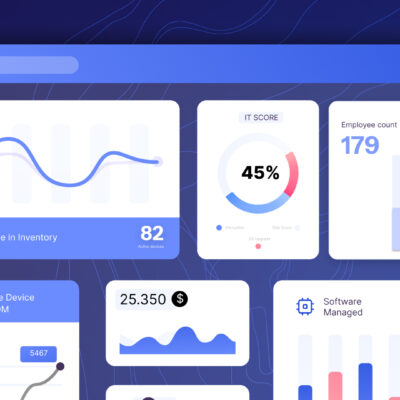What is IT Process Automation?
Automation is the most powerful tool businesses can leverage to increase efficiency, reduce costs, and advance growth. IT process automation (ITPA) empowers businesses to automate repetitive IT tasks, freeing up valuable time and resources for more strategic endeavors. This blog has everything you need to know about IT process automation and its benefits.
What is IT Process Automation?
Before delving into its benefits, let’s first understand what IT process automation entails. At its core, IT process automation refers to the automation of repetitive tasks, workflows, and processes within the IT environment. By leveraging automation tools and software, businesses can streamline operations, reduce manual intervention, and improve overall efficiency.
The Top Benefits of IT Process Automation
- Enhanced Efficiency and Productivity
By automating routine tasks, IT process automation eliminates the need for manual intervention, thereby significantly reducing the time and effort required to complete them. This enables IT teams to focus on more strategic initiatives that drive innovation and business growth. According to a recent survey by Gartner, organizations that implement automation experience a 40% reduction in the time spent on repetitive tasks, leading to substantial gains in productivity.
- Cost Reduction
In addition to boosting efficiency, IT process automation can also yield significant cost savings for organizations. By automating repetitive tasks, businesses can lower labor costs associated with manual intervention, minimize the risk of errors, and optimize resource utilization. According to a study by McKinsey, companies that embrace automation technologies can reduce operational costs by up to 30%, resulting in substantial bottom-line savings.
- Improved Accuracy and Compliance
Manual processes are inherently prone to errors, which can have far-reaching consequences for businesses, particularly in regulated industries. IT process automation helps mitigate this risk by ensuring consistency and accuracy in executing tasks. Moreover, automation workflows can be configured to adhere to regulatory requirements and industry standards, thereby enhancing compliance and minimizing the risk of costly fines and penalties.
- Faster Response Times
In today’s fast-paced business environment, agility is key to staying ahead of the competition. IT process automation enables organizations to respond swiftly to incidents, alerts, and service requests by automating incident management, troubleshooting, and resolution processes. This not only reduces downtime and improves service levels but also enhances the overall customer experience.
- Scalability and Flexibility
As businesses grow and evolve, so do their IT requirements. IT process automation provides the scalability and flexibility needed to adapt to changing demands seamlessly. Whether it’s provisioning new devices, onboarding employees, or scaling cybersecurity measures, automation workflows can be easily customized and scaled to accommodate evolving business needs.
Processes That Can Be Automated with ZenAdmin
Now that we’ve explored the benefits of IT process automation let’s take a closer look at some of the key processes that can be automated using ZenAdmin’s workflows:
- Employee Onboarding and Offboarding
Employee onboarding and offboarding are critical processes that involve numerous manual tasks, such as account provisioning, access management, and equipment allocation. By leveraging ZenAdmin’s automation capabilities, organizations can streamline these processes, ensuring a seamless experience for both new hires and departing employees while reducing administrative overhead.
Read A Complete Guide to an Effective Automated Employee Onboarding and Strategies to Ensure a Secure Offboarding Process.
- Device Procurement and Provisioning
Device procurement and provisioning can be time-consuming and resource-intensive tasks, particularly in large organizations with complex IT infrastructures. ZenAdmin enables businesses to automate the entire device lifecycle management process, from procurement and configuration to deployment and decommissioning, thereby accelerating time-to-market and improving operational efficiency.
- People Management
Managing employee data, performance evaluations, and training schedules can be daunting tasks for HR departments. ZenAdmin’s automation workflows simplify people management processes by automating repetitive tasks, such as data entry, scheduling, and reporting, freeing up HR professionals to focus on strategic initiatives that drive employee engagement and retention.
- Cybersecurity Patches and Upgrades
Cybersecurity is a top priority for organizations across all industries. However, manually managing cybersecurity patches and upgrades can be challenging, leaving systems vulnerable to security threats. ZenAdmin’s automation capabilities enable organizations to automate the patch management process, ensuring timely updates and minimizing the risk of security breaches.
- Reporting and Data Management
Generating reports, analyzing data, and maintaining databases are essential functions for businesses seeking to gain insights into their operations and make informed decisions. ZenAdmin automates these tasks by aggregating data from disparate sources, generating customized reports, and performing routine data management tasks, thereby empowering organizations to derive actionable insights and drive business growth.
Steps of Automating IT Processes with ZenAdmin
Now that we’ve identified the processes that can be automated using ZenAdmin’s workflows let’s explore the steps involved in implementing IT process automation:
- Identify Automation Opportunities
The first step in automating IT processes is to identify potential automation opportunities within your organization. This involves assessing existing workflows, identifying repetitive tasks, and determining which processes can benefit from automation.
- Define Automation Workflows
Once automation opportunities have been identified, the next step is to define automation workflows using ZenAdmin’s intuitive interface. This involves mapping out the steps involved in each process, specifying triggers and conditions, and configuring automation rules to streamline task execution.
- Test and Iterate
After defining automation workflows, it’s essential to test them in a controlled environment to ensure they function as intended. ZenAdmin’s testing capabilities allow organizations to validate automation workflows, identify any issues or bottlenecks, and make necessary adjustments before start using them.
According to a 2020 report by Workato, 94% of respondents say they would rather use a unified platform integrating their applications and building workflow automation than rely on several systems. This is exactly why ZenAdmin is your right choice.
In conclusion, IT process automation offers a myriad of benefits for organizations seeking to streamline operations, reduce costs, and enhance productivity. By automating repetitive tasks and workflows with innovative solutions like ZenAdmin, businesses can unlock new levels of efficiency, agility, and scalability, enabling them to stay ahead in the competitive landscape.











